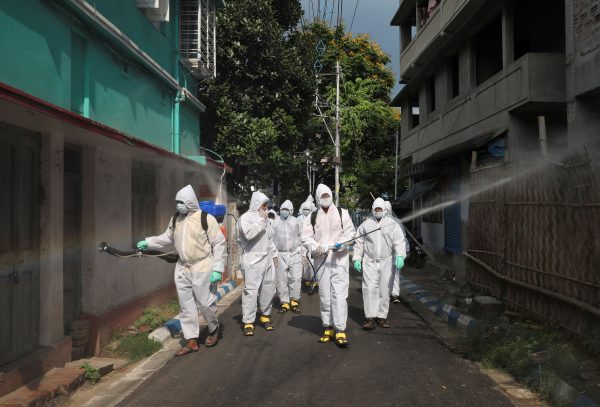Last year, over one million doctors were registered with the Medical Council of India. Assuming 80 per cent of these doctors are available to work and with a population of over 1.3 billion, India’s doctor to patient ratio is 0.67 doctors for every 1000 people. This falls beneath the World Health Organization’s (WHO) recommendation of one doctor per 1000 people. In China, by comparison, the ratio is supposedly 1.8 doctors per 1000 people. On top of low doctor numbers, India has few beds in hospital isolation wards and intensive care units — crucial in caring for COVID-19 patients.
Critical care staff are also lacking in India’s hospitals. In 2016, the Medical Association of India concluded that India needed more than 50,000 critical care specialists — it had only 8350. The situation remains dire. Regular hand washing with clean water and soap is strongly recommended by the WHO. But 50.7 per cent of India’s rural population does not have access to basic hand washing facilities — including soap and water — according to UNICEF and the World Bank. In urban areas, the figure is 20.2 per cent.
COVID-19 cases are also significantly under reported. Large numbers of patients suspected of dying from COVID-19 are recorded as ‘acute respiratory illnesses’ fatalities. This problem is further compounded because doctors are often unable to test the relatives and close contacts of the deceased. This increases the difficulty of implementing quarantine or isolation measures for possible carriers of COVID-19.
India also has a shortage of chemical reagents needed for COVID-19 tests. This is further complicated by its ageing and irregularly-serviced testing infrastructure. Indeed, Prime Minister Narendra Modi’s government wrote in a submission to India’s Supreme Court that it did not have the capacity to conduct more than 15,000 COVID-19 tests per day. Many rural public hospitals do not have personal protective equipment. Doctors are reluctant to treat anyone with COVID-19 symptoms as a consequence.
Without a vaccine, accurate contact tracing is critical to fighting the spread of COVID-19. But with so little testing, this tool is ineffectual in India. In early March, Indian authorities were still not conducting temperature checks on international arrivals at airports. And India only closed its airports to international airlines on 14 March — too little, too late.
Instead of taking proper steps to contain the spread of COVID-19 early on, the Modi government was busy organising ‘Namaste Trump’ rallies for US President Donald Trump’s visit to New Delhi and Ahmedabad. These gatherings may well have accelerated early community transmission of COVID-19. After Trump’s visit, the government reverted back to its old political agenda rather than focussing on the emerging health crisis. It intensified efforts to demonise and arrest protesters dissatisfied with the changes to India’s Citizens Amendment Act.
When it became clear that the health situation had got out of hand, the Modi government panicked. On 24 March, it declared a 21-day India-wide lockdown — with no exceptions — giving three hours’ notice. Little planning went into the decision. Few in the government understood that more than half of India’s population cannot afford to store food to last them for 21 days. The question of how people living below the poverty line would survive was given no consideration. The lockdown was then extended by a further three weeks — increasing hardship for the country’s poorest.
Government preparations for the lockdown were inadequate. For example, on 4 April, The Indian Express exposed that between 20,000–30,000 ventilators were lying dysfunctional across the country’s hospitals. Cramped household conditions across the country also exacerbate the risk of infection and rapid community spread. India’s dilapidated public health system is poorly equipped to cope with the present crisis.
The government must carry out intensive testing and extensive contact tracing. This will assist in identifying all asymptomatic and symptomatic COVID-19 cases so they can be isolated and offered adequate medical care. Users and owners of malls, restaurants, places of worship and cinema halls must be better educated on the necessity of maintaining social distancing.
Alongside body temperature testing, all public places and offices need to provide hand sanitiser and adequate hand-washing facilities. The government must also encourage every smartphone user to download an app similar to those developed by governments in Singapore and Australia. The app should notify health authorities when a person comes in contact with a confirmed case of COVID-19.
Now that it’s started, it would be calamitous to ease the lockdown before putting further necessary steps in place. Any easing of restrictions will also need to be staggered. For example, only allowing a few students per classroom in schools, with the gradual introduction of teaching for different subjects. Indeed, if India is to prevent waves of infections it is critical policymakers proceed cautiously while focussing their efforts on the health crisis rather than the politics of the day.
Dr Vidya S Sharma advises on country risks and technology-based joint ventures at Sharma & Associates, Melbourne.
This article is part of an EAF special feature series on the novel coronavirus crisis and its impact.
A longer earlier version of this article was originally published here in EU Reporter.

